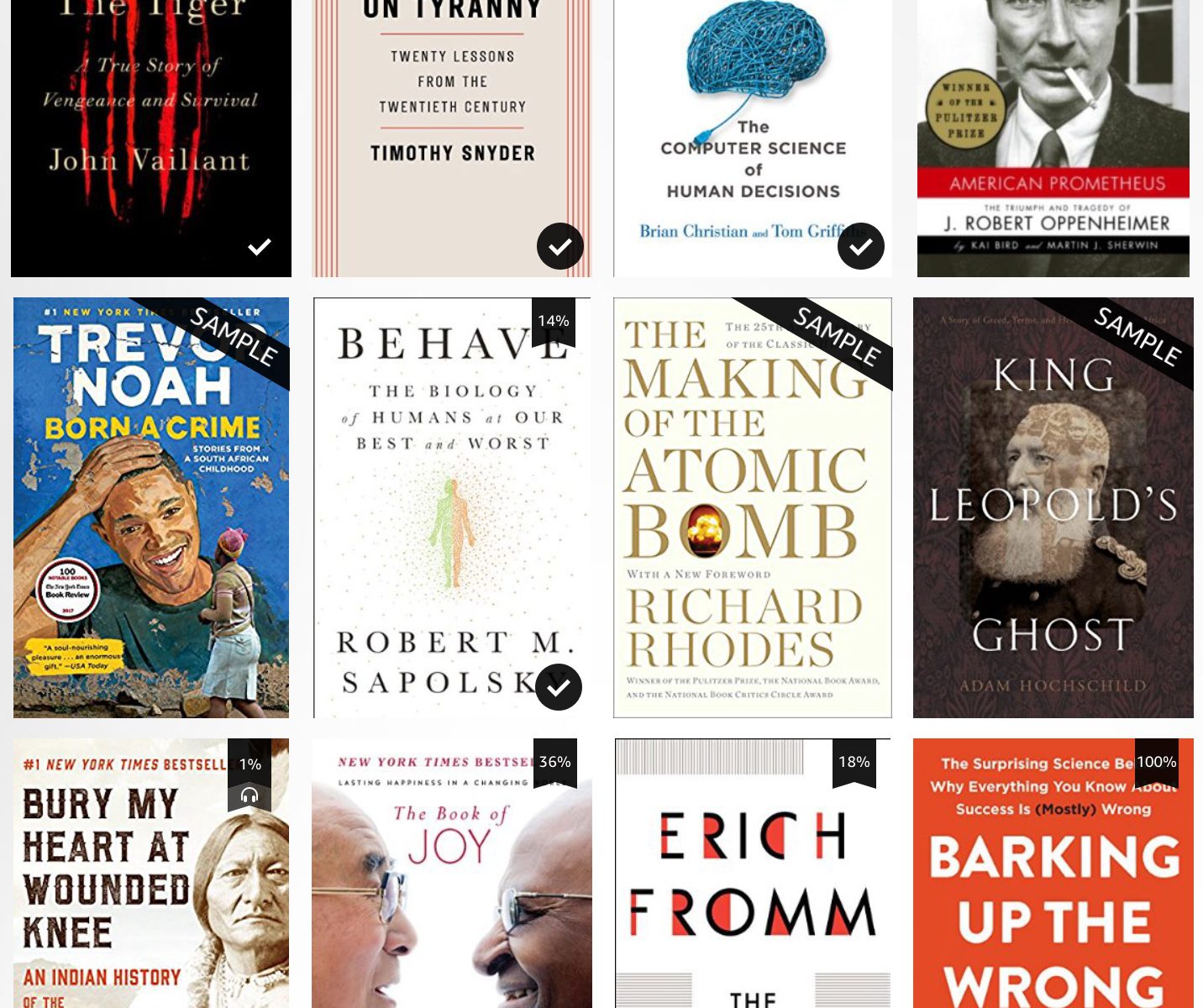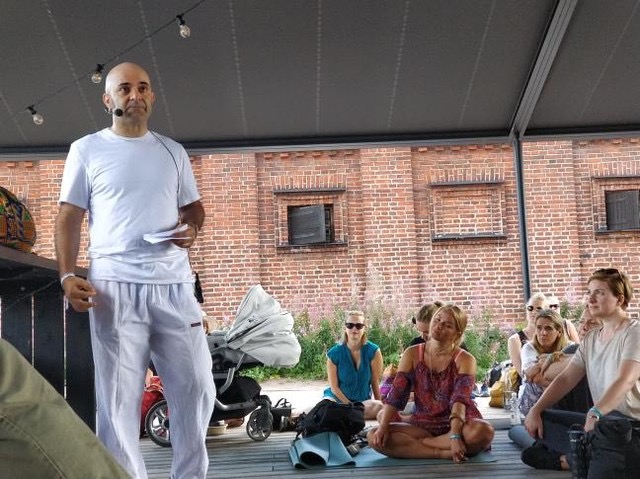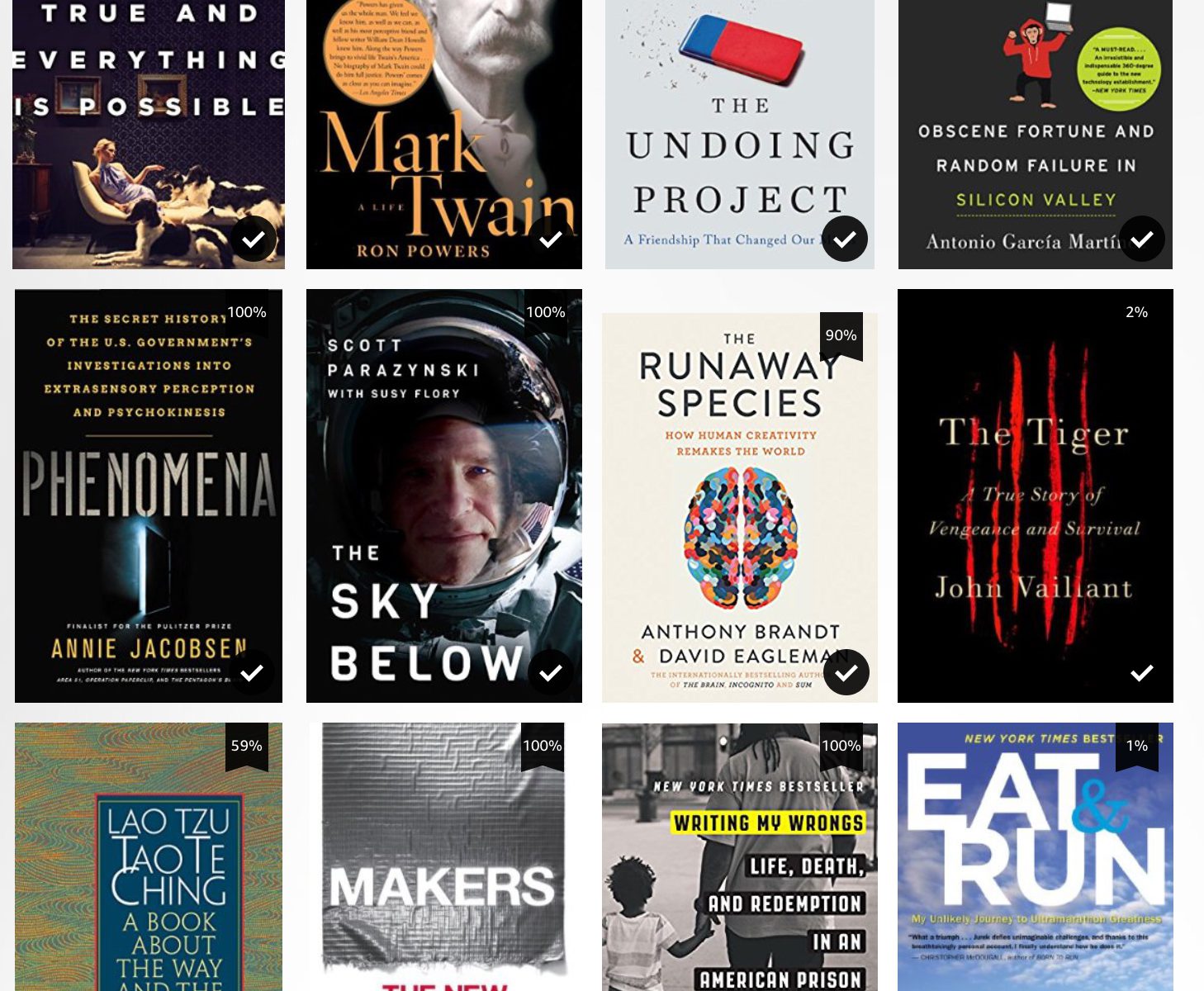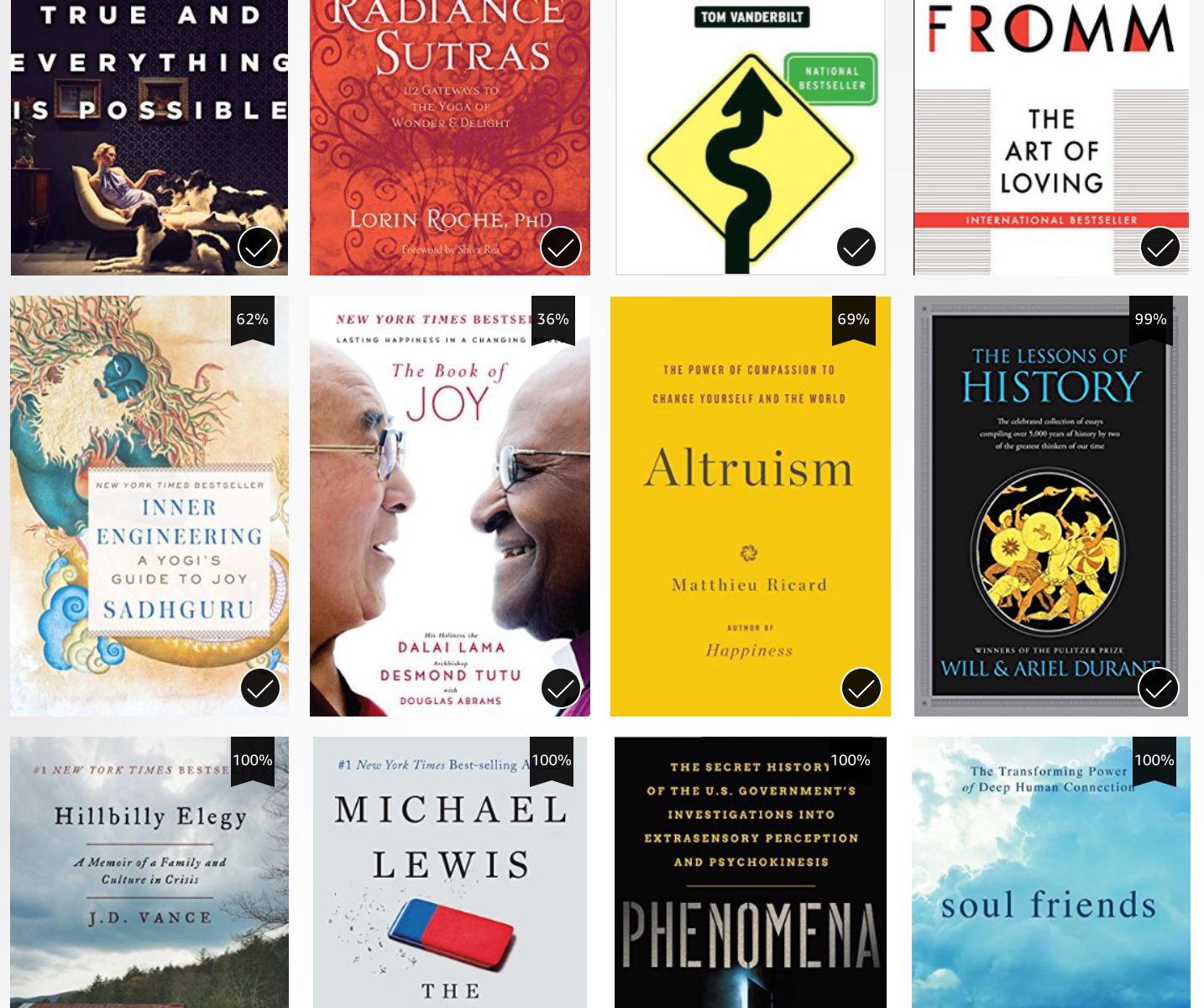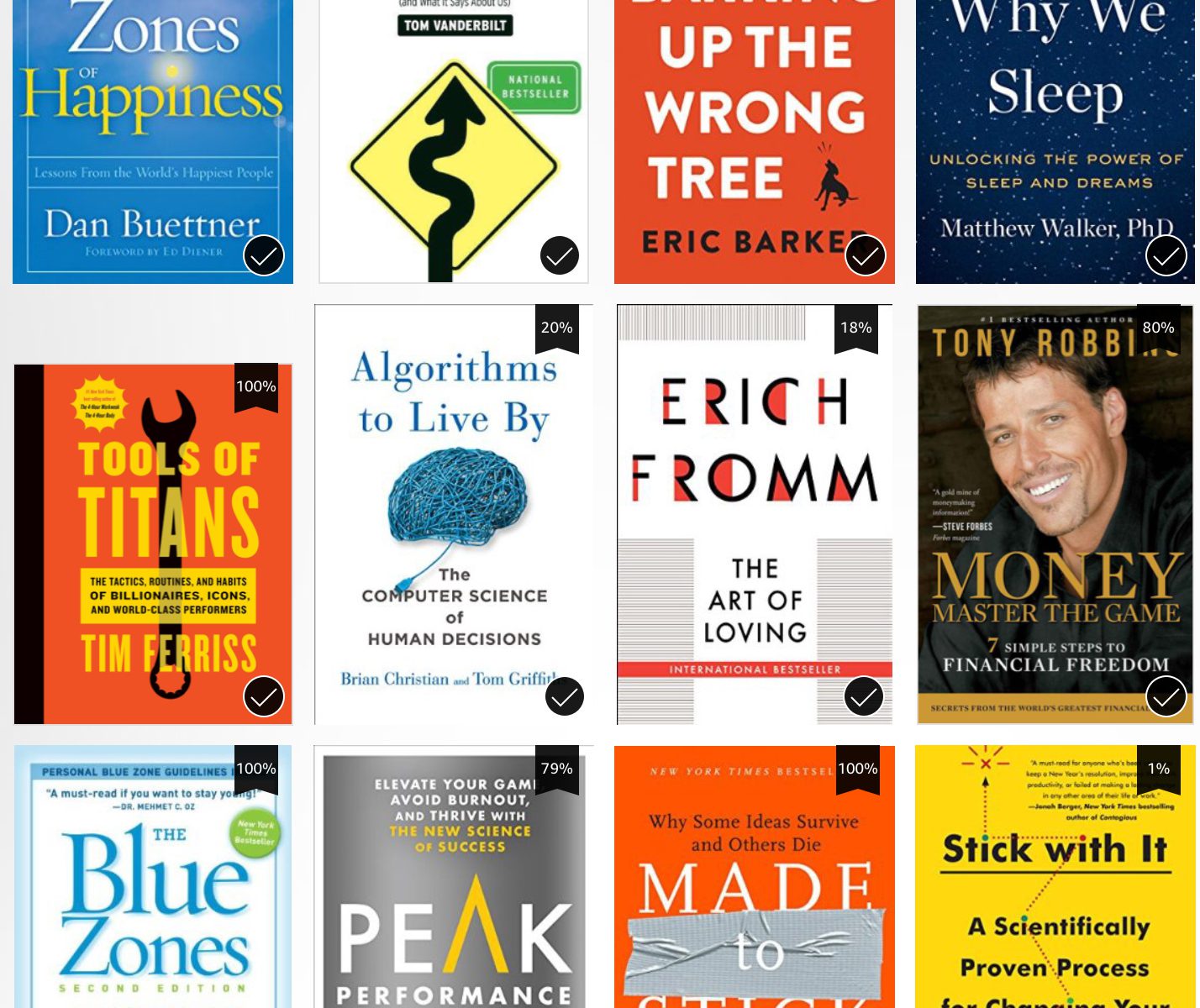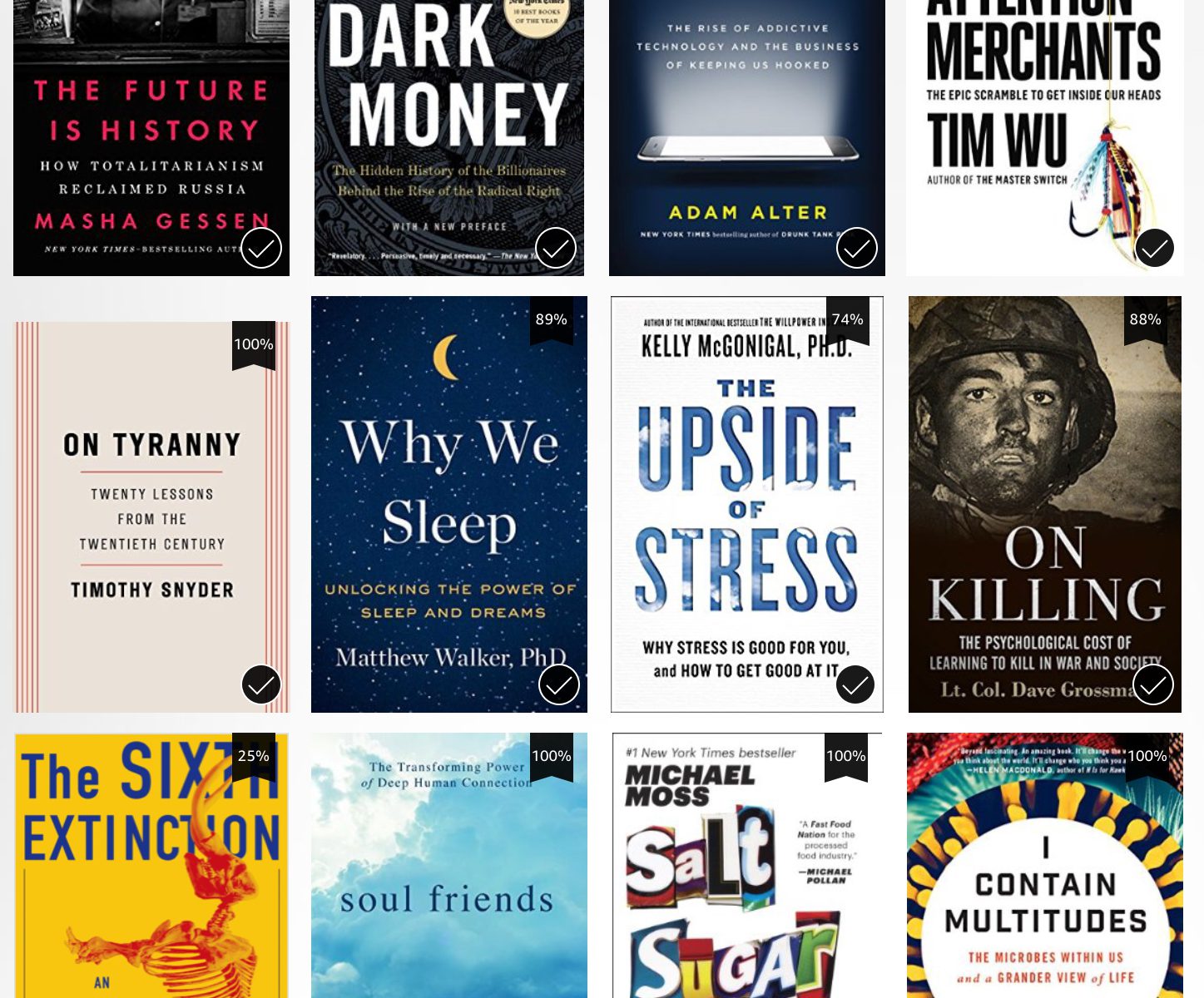The following are the books and courses I found the most useful amongst the 130 I read in 2017. Whether it’s for learning a new skill, managing yourself, or understanding the complexities of the world, these books all offered information that could tangibly improve your life. A rating of 8/10 means the book is pretty darn good. 9/10 means it’s outstanding. And 10/10 puts it in the Useful Books Hall of Fame. Please go through the entire list. Although the top ten listed are indeed the best of the batch, beyond that the books aren’t ranked, and you don’t want to miss the gems that may be at the end:
Algorithms to Live By: The Computer Science of Human Decisions (2016) by Brian Christian & Tom Griffiths (ebook & print). A good popular science book takes a complex topic and makes it accessible to a wide, non-technical audience. A great popular science book also makes the topic engaging, immediately usable, and a catalyst for finding out even more. This is one of the greats.
It turns that a lot of stupendously smart computer scientists have not just thought about certain everyday problems we have, but also came up with mathematically optimal solutions to them. There’s the explore vs exploit dilemma: at what point do you stop searching for a restaurant or date or job, and just settle on one of the available choices? For that, you use the 37% rule: if you’re considering 100 different options, when you hit #37, select the next candidate that’s better than all you’ve seen so far. That’s from optimal stopping theory. There are more: “Sorting theory tells us how (and whether) to arrange our offices. Caching theory tells us how to fill our closets. Scheduling theory tells us how to fill our time.” I feel like this book initiated me into a secret society that knows a lot more than me about the inner workings of the world. 10/10
Barking Up the Wrong Tree: The Surprising Science Behind Why Everything You Know About Success Is (Mostly) Wrong (2017) by Eric Barker (ebook & print). This book is so chock-full of useful information that I highlighted it over 200 times.
What do I like about it? First, it’s full of great stories that stay with you. There’s James Waters with his mental strategies that got him through Navy SEAL training, a Harvard MBA, and a White House job. There’s Alfredo Quiñones-Hinojosa, the illegal Mexican migrant worker boy who became a world-renowned neurosurgeon at Johns Hopkins. There’s Spencer Glendon with the debilitating ulcerative colitis who became a world-class money manager anyway. Dozens of vivid, funny, inspiring stories of ingenuity, grit, and optimism here.
Second, Barker amply supports all recommendations with research findings. So you will learn fascinating, counterintuitive concepts from social psychology, behavioral economics, game theory, neuroscience, genetics and evolutionary biology. It reminds me of Algorithms to Live By: The Computer Science of Human Decisions, another great book that’s full of ingenious mindhacks.
Third, it’s full of usable unconventional wisdom. Were pirates the progressives of their day? Why do so few valedictorians become millionaires? Why do jerks succeed? (Hint: they ask for what they want and self-promote to their bosses.) No one book will turn you into an overnight success, but this one has a lot of signposts for living a happier, more fulfilling life. You’d be wise to read and share it. 10/10
Tools of Titans: The Tactics, Routines and Habits of Billionaires, Icons, and World-Class Performers (2016) by Tim Ferriss (ebook & print). This is quite possibly the most useful single book I’ve ever read. It’s a collection of interview highlights from Tim’s podcast, so there’s no central theme to it other than Doing Things Better. If you don’t mind the mild inferiority complex you’ll develop from hearing about all of these world-changing folks, you stand to learn a lot. It’s a hefty beast, best read piecemeal as a book of reference rather than something to finish in one sitting. 9/10
Why We Sleep: Unlocking the Power of Sleep and Dreams (2017) by Matthew Walker (ebook & print). This is easily the most important book I read in 2017. Why? Because there is nothing more important in your life than sleep. And Westerners (especially Americans) are chronically sleep-deprived, leading to unnecessary car crashes, illness, and depression. We also have terrible sleep hygiene. I’ve been researching this topic for my own book, so I know this is the only decent, up-to-date book out there on sleep. And it’s fantastic. Walker is a renowned sleep researcher himself at UC Berkeley, featuring some of his original findings in the book. All adults interested in their own health should read this. 9.5/10
Traffic: Why We Drive the Way We Do (and What it Says About Us) (2008) Tom Vanderbilt (ebook & print). I put traffic in the category of “the ubiquitous unexamined” — aspects of life that surround us so completely that we never bother to figure out how they work (electricity and water are two other ones). This long but eminently readable tome covers all aspects of traffic engineering, which turns out to be a serious science with huge explanatory power over our daily lives. He also does a fine job of describing the psychology of traffic, and why we are at our worst when driving. Stress levels of the average commuter match that of a fighter pilot. Having read this, I have a much better understanding of the urban environment. And although I may not have any less road rage than before, at least now I know where it comes from. 8.5/10
Stick With It: A Scientifically Proven Process for Changing Your Life for Good (2017) by Sean D. Young (ebook & print). The seven forces behind lasting change are SCIENCE: Stepladders, Community, Important, Easy, Neurohacks, Captivating, Engrained. Possibly the best book I’ve read on the process of making effective change in one’s life. 9/10
Peak Performance: Elevate Your Game, Avoid Burnout and Thrive With the New Science of Success (2017) by Brad Stulberg and Steve Magness (ebook & print). One of the best books I’ve read on improving personal performance. 9/10
The Blue Zones: 9 Lessons for Living Longer From the People Who’ve Lived the Longest (2012), by Dan Buettner (ebook & print). Dan Buettner’s fantastic 2012 New York Times Magazine Article, “The Island Where People Forgot to Die”, was my introduction to Blue Zones. Are there places in the world where people disproportionately live to be 100 or more? And if so, what’s their secret?
With the backing of National Geographic, Buettner and his crack team of top-notch scientists went around the world and found 5 places that fit the strict Blue Zones criteria: Sardinia, Italy; Okinawa, Japan; Nicoya Peninsula, Costa Rica; the Seventh-Day Adventist community of Loma Linda, California; and the Greek island of Ikaria. These regions have a disproportionately high population of centenarians, up to 50 times the US average. But even more remarkable, their centenarians are independent at a rate far higher than in the US and Europe: 90% vs 15%. What’s going on?
Having gone to medical school and read the NYT Magazine article, I thought I knew what was in the book and thus postponed reading it. That was a mistake. Buettner and team are incredibly thorough in their approach, uncovering details about living a good life that casual observation would miss. And they back every one of their conclusions with as much data as they can.
Definite patterns emerge amongst the various groups. All of them foster a strong sense of community and intergenerational cohesiveness. In Costa Rica, there’s a 99-person village all descended from one person, and there’s a touching picture of a blissed-out 104-year old lady holding her great-great-granddaughter. People hang out with family and friends every day, and the elderly live with their offspring.
All the communities eat a mostly plant-based diet. Exercise is also built into their daily activity. Although it’s safe to say that none of these people have ever stepped into a gym, every day they till fields, work gardens, tend sheep over hilly terrain, and walk around.
Some other data points also emerge. Several of the communities incorporate goat milk products in their diet, which is more nutritious than cow’s milk. Red wine features prominently in the two Mediterranean communities, with Sardinian Cannonau offering an extra dose of antioxidants. Almost all the communities eat diets rich in beans.
Although I hope you find this review useful, there are several reasons to read the book in its entirety. First, there are a lot of practices worth incorporating into your own life that I don’t have room to mention in detail, e.g. “ikigai”, your reason to get up in the morning; “moai”, a group of friends who meet regularly; and turmeric.
Second, by reading the stories of all five communities, you not only get the details but also the gestalt of living a long and fruitful life. Is there a worldview that predisposes to healthy longevity?
Third, the healthy, functioning centenarians profiled will turn your preconceptions of aging upside down. They also have sterling advice to offer: “Eat your vegetables, have a positive outlook, be kind to people, and smile.”
Fourth and most important: do you really have something better to do than learning how to live a long, productive and healthy life? If so, I’d like to know what that is. In the meantime, I also got the book for my parents, and would encourage you to do the same. Its life-affirming message is invigorating and wise for all future centenarians. 10/10
The Blue Zones of Happiness: Lessons from the World’s Happiest People (2017) by Dan Buettner (ebook & print). A National Geographic cover story hooked me into this book, and happiness is my beat anyway, so there really was no avoiding this one. The central idea: if you set up a framework for a more satisfying life, you’re more likely to have one.
Pleasure, purpose, pride: these are the three intertwining strands constituting the robust rope of happiness. The Danes, perennially at the top of world happiness surveys, have a lot of their basic needs met by their generous government services. Danes also have a strong community ethos, so they join lots of clubs and engage in purposeful activities. Costa Ricans, who may have an even stronger community ethos, have lives full of pleasurable moments or “positive affect”: walking to work, joking with friends, playing with their kids. Singaporeans work 60hr weeks to get the 5 C’s: car, condominium, cash, credit card, and club membership. They take pride in their accomplishments, and that supposedly makes them happy. I have not been to Singapore, but the description of their harried, materialistic lives seemed the antipodes of happiness.
What I really appreciate about Buettner’s work is his thoroughness. He goes into the field with a bunch of scientists, gathers the data, crunches the numbers, and presents us with the best practices. That’s why this book led me to his first Blue Zones book, on longevity, which I consider definitive (also reviewed here). He’s also clear-eyed on the benefits of positive psychology: “They may work in the short run, but they almost always fail over time. They’re quick fixes that may evaporate before you know it.” To be happy in the long run, structure a happy life.
I read this book in a day and highlighted 240 passages. It’s fantastic, and should be required reading for all bipeds. As a bonus, the appendix has a collection of Top 10 happiness practices from top experts for individuals and countries. 9.5/10
Money: Master the Game – 7 Simple Steps to Financial Freedom (2016) – Tony Robbins (ebook & print). Let’s get one thing out of the way: I’m a big Tony Robbins fan. Although his style may seem hucksterish, he absolutely definitely positively gets results. This is his first book in over 20 years, and he’s done a lot of homework for it. The core of Tony’s approach is finding out the expert’s best practices, and then implementing them. So he found the most successful money people in the world — Ray Dalio, John Templeton, John Bogle, Carl Icahn, T. Boone Pickens, Warren Buffett, we’re talking trillionaires dammit — and extracted their best practices for us.
Problem: at 700 pages, it’s a bit of a brick, with a ton of information to sift through. But is your financial future not worth 12 hours of your concentrated attention? Yes it is. It’s not about the how of financial freedom, but also the mindset and overcoming your blocks. Be an investor, not a consumer! Harness the awesome power of compounding! Got this one for myself in print and ebook format, and I expect it will return the investment thousands-fold. Unless you already have more than a quarter billion dollars to your name like Tony, you should listen to him. 9.5/10
The Art of Loving (1956) by Erich Fromm (ebook & print). This is a classic by a guy who should be far more widely read in this country. Heck, if I was King of the Universe, I’d make it mandatory reading for every high school kid. This guy drops truth bomb like Kissinger on Cambodia: surreptitiously but in abundance. Here’s one: “It is hardly necessary to stress the fact that the ability to love as an act of giving depends on the character development of the person. It presupposes the attainment of a predominantly productive orientation; in this orientation the person has overcome dependency, narcissistic omnipotence, the wish to exploit others, or to hoard, and has acquired faith in his own human powers, courage to rely on his powers in the attainment of his goals. To the degree that these qualities are lacking, he is afraid of giving himself—hence of loving.” Damn! 80 highlights in 104 pages = most highlights per page of any book I’ve ever read. Insanely prescient; everything he said 50 years ago rings true today. No one should get married before reading and internalizing this first. 10/10
Outsmart Yourself: Brain-Based Strategies for a Better You (2016) by Prof Peter M Vishton (Great Courses). There is self-help mumbo-jumbo from self-proclaimed gurus with no credentials, and then there is scientifically-validated advice for changing your behavior by using your brain properly. Per the course This course is the latter. Like how? “Want to curb a few bad habits? Try making a notebook entry every time you perform the habit. Have a big project and feel the urge to procrastinate? Do nothing for 20 minutes and you’ll feel ready to get to work. Come down with a case of the blues? Eat some fermented foods such as yogurt or sourdough bread.” Another outstanding course from The Teaching Company/Great Courses.
The Nature Fix: Why Nature Makes Us Happier, Healthier, and More Creative (2017) by Florence Williams (ebook & print). “We don’t experience natural environments enough to realize how restored they can make us feel, nor are we aware that studies also show they make us healthier, more creative, more empathetic and more apt to engage with the world and with each other. Nature, it turns out, is good for civilization.” Williams gamely camps with neuroscientists in Colorado, experiences shinrin yoku (“forest bathing”) in Japan, straps on a portable aethelometer (soot-measurer) in DC, rambles in Scotland, hikes in Finland, and visits a Korean “healing forest.”
Through her chatty anecdotes, she presents the evidence that nature strengthens your immune system, lowers stress, increases creativity, decreases rumination, and calms down hyperactive kids. I appreciated her exposition of the great E.O. Wilson’s biophilia hypothesis, which “posits that peaceful or nurturing elements of nature helped us regain equanimity, cognitive clarity, empathy and hope.” Minimum recommended does of nature: 5 hrs/month. An excellent and persuasive popular science book. 8/10
Disrupt You!: Master Personal Transformation, Seize Opportunity, and Thrive in the Era of Endless Innovation (2015), by Jay Samit (ebook & print). “You have a choice: pursue your dreams or be hired by someone else to help them fulfill their dreams. The great disruptors constantly reinvent themselves and their careers. They never fear losing their jobs, because they create jobs. They control their own destinies. This book is written to answer two very basic questions: How did they do it? How can I do it? The third question is entirely up to you: Will you do it?” I knew Jay from our Los Angeles networking group. I respected the clarity of his thinking and a communication style that cut through bullshit like an argon laser through plastic. His book does not disappoint. “Being a disruptor is simply a state of mind. It is the ability to look for opportunity in every obstacle, to respond to every setback as a new beginning.” Equal parts about both personal and industry disruption, it’s one of the best books on entrepreneurship I’ve read in recent memory.
Whether as a self-employed entrepreneur or top executive in companies like Sony and EMI Music, Samit is a master of taking calculated risks. His anecdotes about creating technologies slightly ahead of their time, reinventing himself multiple times, and accomplishing the seemingly impossible are bold, instructive and inspiring. Read it for a potent shot in the arm that just might awaken the entrepreneurial spirit in you. 9/10
Made to Stick: Why Some Ideas Survive and Others Die (2007) by Chip & Dan Heath (ebook & print). Simple, Unexpected, Concrete, Credible, Emotional Stories: those are the 6 principles of “SUCCES” for communicating your ideas effectively that the brothers Heath lay out in their highly readable, usable, memorable book. Their other books follow a similar structure, with mnemonics, fun case studies, and summaries at the end of each chapter. I recommend all of their works. 9/10
The Achievement Habit: Stop Wishing, Start Doing, and Take Command of Your Life (2015) by Bernard Roth (ebook and print). Roth is one of the co-founders of the Stanford d.school, one of the originators of design thinking, and a professor of mechanical engineering for 40 years. His book is, indeed, partly about achievement. More than that, it’s a collection of life wisdom from a very smart, accomplished, empathetic doer, maker, and teacher who has figured out how to get results from himself and students.
Foremost in Roth’s teachings is bias towards action. Instead of waffling and ruminating, “don’t get caught up in how you’re going to get it just right. That’s what causes people to shut down and never get started. Avoid the desire for perfection right out of the gate. Instead, tell yourself that you’re prototyping your screenplay or your dress. The final version can come later.”
Some of his suggestions may seem radical, but they’re just part of standard d.school curriculum, e.g. getting rid of reasons for doing things. You don’t need them, and they’re all bogus anyway: “Many reasons are simply excuses to hide the fact that we are not willing to give something a high enough priority in our lives.” Substitute all manifestations of “but” with “and.” When you gather up your intention and concentrate your attention, you will move mountains.
There’s a ton of actionable advice here, such as a list of 22 ways to get unstuck (e.g. lists, idea logs, humor, conversation, exercise, compressed conflict, mind maps, working backward), and the “Your Turn” exercises at the end of each section. This is a tremendously useful and encouraging book for anyone whose creative endeavors could use some more bias towards action. 9.5/10
The Power of Persuasion: How We’re Bought and Sold (2005) by Robert A. Levine, Ph.D. (ebook & print) “The psychology of persuasion emanates from three directions: the characteristics of the source, the mind-set of the target person, and the psychological context within which the communication takes place.” Thus begins this revelatory and sobering treatise on the ways humans fool themselves and others. A professor and practicing psychologist for 40+ years, Levine signed up to experience firsthand the persuasive techniques of people like car dealers, door-to-door salesmen (Cutco knives), and cult leaders (the Moonies). One of his key insights is that no one is impervious; we are all susceptible. The persuasiveness triad: “perceived authority, honesty, and likability.” Americans are particularly susceptible to the authority symbols of titles, clothing, and luxury cars (see: current US president). Decisive, swift talkers are no more sure of their facts than more hesitant counterparts, but they create an impression of confidence that audiences perceive as more expert and intelligent. The more jargon you use and the less a jury understands a witness, the more convincing she appears.
Aside from the dismaying news that we’re all patsies waiting to be taken, the book is full of entertaining, insightful stories on scoundrels ranging from psychics to gurus. Moonies recruit in a trademark sequence of “pickup, first date, love bomb”, creeping up on victims with imperceptible subtlety that ultimately engulfs them. Levine’s account of the 10-step method of car salesmen was particularly revelatory and unsettling in the frankness of its manipulation.
The most gripping part of the book was Levine’s depiction of the final hours of the Jonestown cult of Jim Jones, during which 900 members committed suicide by drinking cyanide-laced Kool-Aid, even after witnessing their own infants’ agonizing death throes. To read the transcript of the recording of those hours, and how people just like you and me were rooting for their own demise out of loyalty to a demented and manipulative leader, is to understand how tyranny works, and how it is happening right here, right now. 8.5/10
The Talent Code: Greatness Isn’t Born. It’s Grown. Here’s How (2009) by Daniel Coyle (ebook & print). The information in this book has kept well even though it’s 8 years old. How does the tiny island of Curaçao produce a hugely disproportionate number of world-class Little Leaguer baseball players? What’s the secret to Moscow’s run-down Spartak Tennis Club suddenly churning out Grand Slam winners? Where did all these South Korean female golf champions come from? Coyle travels to hotbeds of talent all over the world to distill the essence of exceptional performance. Deep practice (aka “deliberate practice”) is essential, involving practicing to the edge of one’s ability while getting timely feedback. Some kind of spark seems to be necessary to fuel the “rage to mastery.” It’s interesting that a disproportionate number of historical figures — Caesar, Napoleon, Washington, Jefferson, Newton, Michelangelo, da Vinci, Twain — were orphans. And finally, having a master coach definitely helps. There are priceless insights into the slow, attentive, straightforward ways legends like John Wooden got results. Coyle’s odd obsession with myelin as the alpha and omega of learning and mastery is misplaced. Otherwise, the book has a ton of actionable information for creatives and teachers. It’s also fun to read. For just the usable facts and none of the stories, I refer you to Coyle’s The Little Book of Talent: 52 Tips for Improving Skills. 8/10
Principles: Life and Work (2017) by Ray Dalio (ebook, print & audio). This is three books in one: a memoir, life advice, and business advice. Dalio is the founder of Bridgewater Capital, the world’s largest hedge fund, which he started from nothing in 1975 to $150 billion in assets today, amassing a personal fortune of $17 billion along the way. What impresses me about Dalio is that he arrived at his wealth mostly through very careful decision-making and self-observation, which he was then smart enough to encode as principles. That kind of meticulous thinking led to his firm foreseeing the crash of 2008 and even profiting from it. This book is the end result of those principles time-tested and market-validated over 40 years.
Dalio’s frank style of describing his triumphs and mistakes keeps this book from lapsing into self-aggrandizement. He’s hobnobbed with every major world player over the past 4 decades, making for some fun anecdotes. The work principles that have made Bridgewater famous worldwide for its radical openness would form a firm foundation that many companies would be wise to emulate. 9/10
The 7 Secrets of the Prolific: The Definitive Guide to Overcoming Procrastination, Perfectionism, and Writer’s Block (2011) by Hillary Rettig (ebook). Artists, especially writers, who would like to overcome procrastination and produce more, take notice. Rettig decriminalizes procrastination and prohibits self-shaming: “The use of shame and coercion as motivational tools, even on yourself, is not just immoral, but futile. They yield not growth and evolution, but, at best, short-term compliance. They also sabotage the creative process.” Instead, she identifies perfectionism as the real culprit and Compassionate Objectivity as its antidote. She offers six more solutions, as well as how to implement them, such as:
• Develop the Habit of Abundant Rewards and No Punishments: rewards yourself a lot for getting stuff done
• Build Your Capacity for Fearless Writing via Timed Writing Exercises: I’ve found setting a timer to be miraculously effective. Get it get stuff done.
I’m also a huge fan of her Three Productivity Behaviors: “(1) showing up exactly on time, (2) doing exactly what you are supposed to be doing, and (3) doing it uninterruptedly (except for small breaks) for long periods of time.”
I particularly appreciate Rettig’s unequivocal advice to self-publish your books, entirely bypassing the sclerotic traditional publishing industry. She validates the suffering of authors at the hands of prima donna agents and capricious publishers who aren’t really invested in your career. Taking control is the best decision you can make, and more profitable to boot.
In its 182 pages, this book contains zero padding and more actionable wisdom than books three times the length, all coming from a well of deep compassion and understanding. I’ll be referring to this one for a long time to come. 9/10
Entrepreneurial You: Monetize Your Expertise, Create Multiple Income Streams, and Thrive (2017) by Dorie Clark (ebook & print). Solo entrepreneurs, small business owners, domain experts, location-independent knowledge workers, or those who aspire to work for themselves instead of being a corporate cog, take notice: “Becoming a recognized expert these days doesn’t always lead to money. The elephant in the room of modern entrepreneurship is that even people who seem to be at the top of their game aren’t always monetizing successfully. Learning to make money from your expertise is a different skill set from what’s needed to become excellent at your work or well-known in your field.”
What I like about it:
1) It’s concise, well-researched and inspiring. Dorie is not only a first-rate chronicler of the rapid changes in modern work (through the other books in the trilogy, Reinventing You and Stand Out), but she’s also lived at the forefront of these changes. She’s held jobs all the way from stringer for a local newspaper, to political campaign staffer, to corporate consultant. If she’s a sought-after speaker and independent consultant now, it’s all via bootstrapping and sheer hustle. Her story and that of other successful entrepreneurs gives you a roadmap for us to follow.
2) Radical transparency. Dorie provides dollar figures for how much more (or less) money she made as a result of certain changes, as well as those from such luminaries as Pat Flynn. Most books shy away from such disclosures. EY openly features this information crucial to setting realistic goals and expectations.
3) Practicality. Dorie provides concrete actions for the three steps to sustainable monetization: building your brand; monetizing your expertise; extending your reach and impact online. And then, she gives us seven golden tactics for accomplishing those three steps: coaching/consulting; public speaking; podcasting; blogging; live conferences; online communities; and selling products.
Dorie illustrates each of these tactics with real-life examples from top-flight practitioners. For example, for podcasting, there’s Jordan Harbinger (The Art of Charm) and John Lee Dumas (Entrepreneur on Fire). For blogging and email list-building, there’s James Clear (400,000 emails!). For conferences, Jayson Gaignard of Mastermind Talks; for community building, Ryan Levesque. The stories of their process to success are very motivating.
Although the strategies and tactics Dorie enumerates are accessible to all, you need to know that every one of these profiled people has an exceptional work ethic, starting with Dorie herself. These are elite hustlers at the top 0.1% of the population. Are you willing to commit to the work?
If so, then Entrepreneurial You provides a fantastic framework that will not only save you years of wasted effort but also provide you with ample yes-you-can motivation ammunition. Dorie Clark has written the go-to reference for prosperity, impact and fulfillment in the internet age. Get it to go big. 9/10
The Four Tendencies: The Indispensable Personality Profiles That Reveal How to Make Your Life Better (and Other People’s Lives Better, Too) (2017) by Gretchen Rubin (ebook & print). As a rule, I am skeptical of personality profiles. None are scientifically validated, except for the OCEAN framework (Openness, Conscientiousness, Extraversion, Agreeableness, Neuroticism). The rest are fabricated from thin air with scant experimental support, especially frameworks like the Enneagram and the laughable Myers-Briggs inventory. Sure, you can ask people two questions, like “Do you like barbecued spare ribs?” and “Are you a cat person or a dog person?”, and end up with a 2×2 matrix that tidily divides up the population into 4 categories. But does that have any predictive value outside of a person’s tendency to attend or avoid barbecues with dogs at them?
This book is a follow-up to Gretchen’s last book, Better Than Before, in which she more fully lays out the Four Tendencies that emerge from the answers to two questions: “How do you handle internal commitments?” and “How do you handle external commitments?” Good with both makes you an Upholder; bad with both makes you a Rebel. Obligers are good with external commitments but bad with internal ones; Questioners are the inverse.
The problem is that, depending on time of day, fullness of tummy, looming deadlines, who’s President, and how well last night’s poker session went, I will give different responses to Gretchen’s questionnaire. Sometimes, I’m an Obliger; other times a Questioner; and less often, a Rebel or Upholder. These are not hard-wired aspects of a personality encoded in genes, and to her credit, Gretchen does call them tendencies rather than traits.
Gretchen’s thoughts make up only about half of the book. The other half comprises quotes from her blog readers about how the tendencies show up in their lives. That said, the book was hugely useful in one respect: it made me realize that I work much better when I have external accountability. That insight alone is fully worth 3 hours of my life and $15. 8/10
Transformational NLP: A New Psychology (2017) by Carl Buchheit and Ellie Schamber (ebook & print). This book begins with a comprehensive history of Neuro-Linguistic Programming, where you will find pioneering insights from Grinder, Bandler, Dilts and Steve Andreas. This leads into the exposition of Transformational NLP, as developed by Jonathan Rice and Buchheit himself. This passage about picking unsuitable partners summarizes a lot of its principles:
“The creature brain does not care whether or not the human brain is happy; it cares only about its survival in physical reality. In the remarkable non-logic of creature-level association, the terrible pain of abandonment (in this example) becomes necessary for continued survival precisely because it could have been fatal, but was survived. Because this terrible pain has been survived, it becomes an experience profoundly associated with survival, and actually becomes essential for future survival. Something that is essential for basic survival cannot be permitted to change even a little bit, so the patterning that controls it will be quarantined. Once it becomes quarantined, unless there is an unusually effective intervention, the patterning will never change. Consequently, the core decisions/ beliefs generated by this patterning will never really change, no matter what happens later. The person will go through his/her life both resisting and expecting abandonment, hoping and working for love while waiting to be unwanted and left.”
The book also offers deep insight into how to effectively heal the past: “The goal is to empower the client to view the past not as a fixed source of immutable loss, but rather as a dynamic wellspring of creative decision-making and learning.”
Carl’s been at this for over 30 years, so his observations and therapeutic strategies come from a deep well of experience. There are insights on every other page of this book that would take lifetimes to realize on one’s own. This is essential reading for therapists who want to achieve breakthroughs in treating clients or healing yourself. 8.5/10
Getting Past No: Negotiating in Difficult Situations (1993) by William Ury (ebook & print). “The essence of breakthrough strategy is indirect action. It requires you to do the opposite of what you naturally feel like doing in difficult situations.” Ury, the grandaddy of the Harvard Negotiation Project, proposes a five-step “joint problem-solving” protocol as the way to get past no: “Only they can break through their own resistance; your job is to help them.” The steps: go to the balcony; overcome the other side’s negative emotions by listening to them; reframe the problem; build them a golden bridge; use power to educate. Also remember the five important points along the way to a mutually satisfactory agreement: interests, options for satisfying those interests, standards for fair resolution, alternatives to negotiation, and proposals for agreement. I highlighted 122 passages from this book, so there’s a plethora of practical wisdom here. 9/10
Altruism: The Power of Compassion to Change Yourself and the World (2015) by Matthieu Ricard (ebook, print and audio). I picked up Altruism at Matthieu Ricard’s reading in San Francisco two years ago. Ricard is a remarkable man: Tibetan Buddhist monk with over 30,000 hours of meditation under his belt; French translator to the Dalai Lama; PhD from Institut Pasteur under Nobelist François Jacob; and current title-holder for “world’s happiest man”, according to brain scans done at Richard Davidson’s lab.
This kind of book is required reading in my line of work, especially when written with the rigor and depth that Ricard brings. At 43 chapters and 849 pages, it has the heft of a brick, and the density, too, with tangled sentences like this: “It now had to be demonstrated that people don’t act solely in order to avoid having to justify their non-intervention to themselves either.”
A magnum opus like this takes 5-10x longer to read than the average book. But the rewards can be immense. Ricard brings massive evidence arguing for altruism as an essential part of our human and animal makeup, even beyond the genetic arguments of kin selection. This has far-reaching consequences in how we run our lives, interact with others, and treat the planet. (NB: also featured in “Important”) 9.5/10
59 Seconds: Change Your Life in Under a Minute (2009) by Richard Wiseman (ebook & print). Bonding over shared dislikes works better than discussing shared enthusiasms. Active listening does not improve relationships. Sit in the middle of a table to make a good impression. Rhyming persuades. Wiseman, perhaps the only person with the job title “Professor of the Public Understanding of Psychology”, offers bite-sized, scientifically validated tips on happiness, persuasion, motivation, creativity, attraction, relationships, stress, decision making, parenting and personality. Fun, fast, stupendously useful read. 9/10
The Compass of Pleasure: How Our Brains Make Fatty Foods, Orgasm, Exercise, Marijuana, Generosity, Vodka, Learning and Gambling Feel So Good (2012) by David J Linden (ebook & paperback). “While we might assume that the anatomical region most closely governed by laws, religious prohibitions, and social mores is the genitalia, or the mouth, or the vocal cords, it is actually the medial forebrain pleasure circuit.” Thus begins this riveting account of how the human brain gets us in hot water. Prof Linden knows his stuff, and the explanatory power of this book about ubiquitous but perplexing phenomena like drug addiction, obesity, falling in love, and deer fighting over yellow snow (?!) is staggering. He explains the science with great clarity and humor without compromising the sophistication of the discourse. 9/10
Pitch Anything: An Innovative Method for Presenting, Persuading, and Winning the Deal (2011) Oren Klaff (ebook & print). Although I can’t claim to have used this protocol for an actual sale, Klaff has, and with sepctacular results. His methods mesh with everything I’ve practiced and studied about persuasion and have the ring of truth. Highly recommended if your work involves sales. 9/10
Real Artists Don’t Starve: Timeless Strategies for Thriving in the New Creative Age by Jeff Goins (ebook & print). Goins, an independent author whose methods are well worth emulating, lays out the 12 Rules of the New Renaissance distinguishing Starving Artists from Thriving Artists. Some of the ones I like:
1. The Starving Artist believes you must be born an artist. The Thriving Artist knows you must become one.
7. The Starving Artist always works alone. The Thriving Artist collaborates with others.
11. The Starving Artist masters one craft. The Thriving Artist masters many.
12. The Starving Artist despises the need for money. The Thriving Artist makes money to make art.
How great is that? He illustrates the rules with engaging stories from real-life artists and entrepreneurs who definitely didn’t starve, from Michelangelo to Jeff Bezos. This book should be the manifesto of all independent artists. I’m going to print his 12 rules and put it up in my workspace right now. Oh, and make sure you have a “leaky mental filter.” 9/10
So Good They Can’t Ignore You: Why Skills Trump Passion in the Quest for the Work You Love by Cal Newport (ebook & print). A professor of computer science at Georgetown and author the Study Hacks blog, Newport makes abundantly clear with both anecdotes and ample scientific evidence that “follow your passion” is terrible career advice. It turns out that mastery gives rise to passion, not the other way around. And when you get really good at what you do, the world will beat a path to your door. His more recent book, Deep Work, is one of my favorites of all time. 9/10
The Big Leap: Conquer Your Hidden Fear and Take Life to the Next Level (2015) by Gay Hendricks (ebook & print). I’d heard of this Hendricks guy before, mostly in the context of relationship advice books. I was pleasantly surprised by this robust call to action and slaying of personal demons. Key insight: the human psyche seeks homeostasis. Therefore it will fight against anything that threatens that equilibrium, including success. Success?! If you don’t believe me, think about a time when you had just gotten a better relationship or job, and you somehow managed to screw it up. Yup, everyone does it. This book proposes some potent remedies. I particularly appreciated the following mantra: “I expand in abundance, success and love every day as I inspire those around me to do the same.” A short 200 pages that pack a punch. 9/10
Pause: Harnessing the Life-Changing Power of Giving Yourself a Break (2017) by Rachael O’Meara (ebook, print & audio). Americans live amidst a culture of misplaced priorities. The richest country in the history of the world is also the only industrialized nation with no mandated paid maternity/paternity leave. Only 4% of companies allow extended paid leave. Work defines people’s identities, and overachievers believe that being busy is the highest virtue. Nothing could be more effective in self-inflicting misery. O’Meara exhorts us to pause and reconsider this mindset and its ramifications: how you got in this mess, how to get out of it, and what to do upon re-entry into polite rat-race society.
Things I like about this book: tons of case studies that you may identify with, including those from luminaries like Gabrielle Bernstein and Danielle LaPorte; step-by-step instructions for initiating your pause; introduction to incredibly useful concepts like self-validated intimacy and strengths finding; great sections on meditation and digital detox; cool exercises, like the “ten-second micro-pauses” of taking 6 deep breaths or breathing into your palms; easy to read.
O’Meara has done a great service by highlighting the importance of taking a pause and providing the tools to make it happen. If you think you’re too busy to pause, that’s like thinking you’re too out-of-shape to exercise: you need this book, stat. I’m hoping this is the beginning of not just a good idea but a great movement to change people’s attitudes towards leading more balanced, happy lives. 8/10

